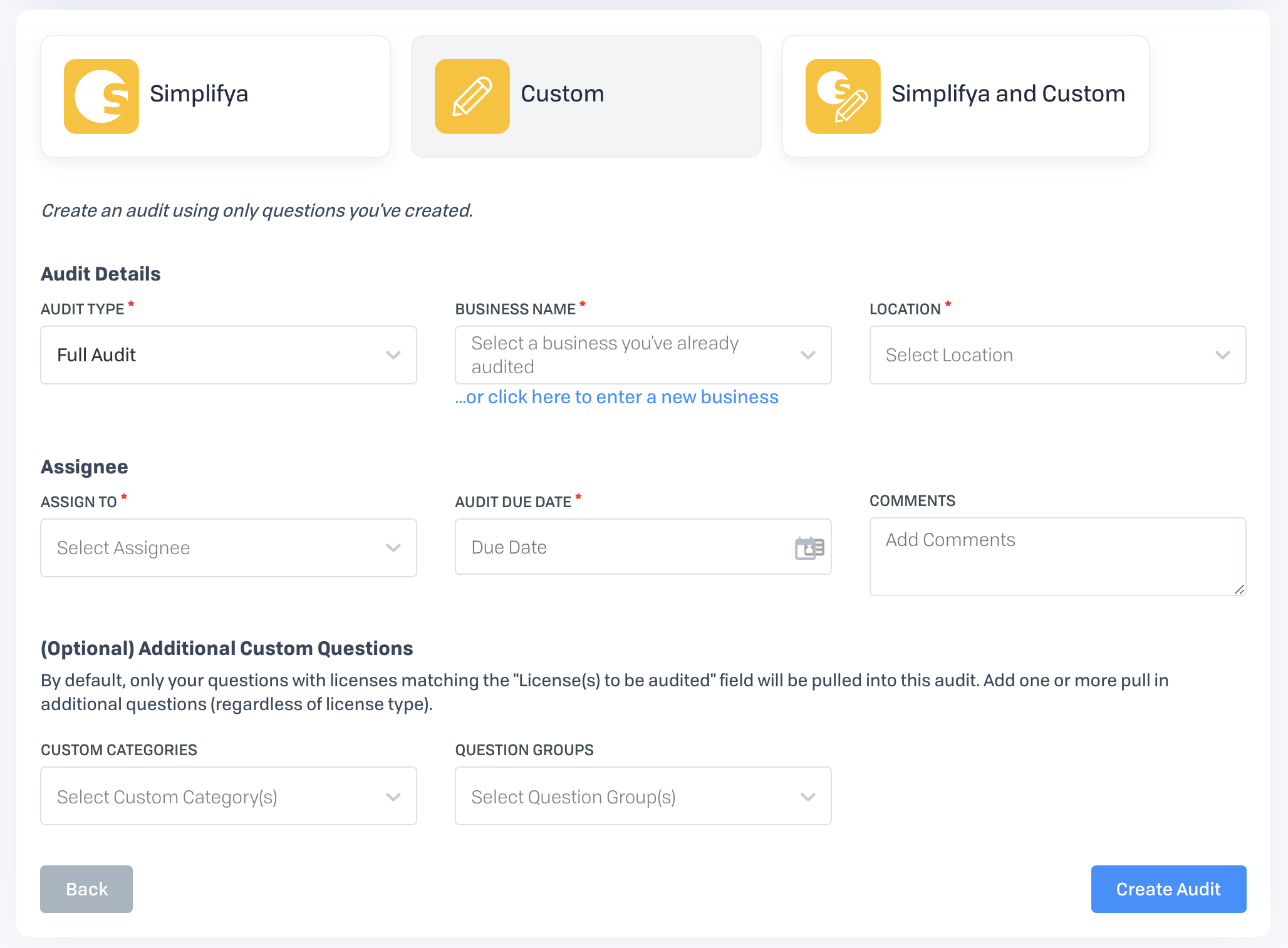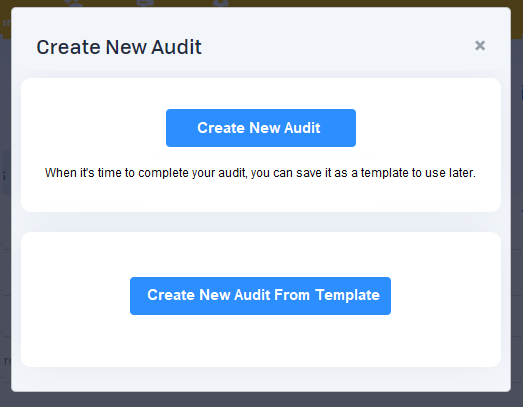As of May 2020, Simplifya's Audits module gives you the ability to add your own audit questions and create audits from them.

To skip ahead:
- Navigating to the "Create Audit" page
- Selecting (or adding) the facility
- Creating your Third-Party Audit
- Permissions
Navigating to the "Create Audit" page
You can assign audits through the "Audits" sub-module. To assign an audit:
- Click the hamburger menu icon in the top right of the screen.
- In the slide-in navigation, select "Audits", and then "Audits".
- While on the "Audits" tab, click the "Create Audit" button.

Upon clicking the "Create Audit" button, you'll be given two options for creating your self audit:
- Create New Audit: Build an audit from scratch.
- Create New Audit From Template: Assign users to conduct an audit from a previously customized audit template (see: Creating and Editing Audit Templates).
|
When creating a new audit, you can save it as an audit template after conducting the audit. |
Selecting (or adding) the facility
On the Create Audit form, one of the first things you'll be prompted to do is select the business facility that you'll be auditing.

Selecting a business you've audited before
If you've already used Simplifya to audit this facility before, simply select it from the "Business Name" dropdown.
Adding a new business
If this is the first time auditing the facility, click the "...or click here to enter a new business." link to add the facility to your dropdown.
Clicking this link will open another form where you can enter all the relevant business information for the facility you're auditing, including:
- Business name
- Address of the facility
- Licenses held at that facility
- Contact information
|
When entering new business info, if the audited facility's city is not listed in the "City" drop-down, it means the business is subject to the regulations of your county. In the "City" drop-down, you should select "Unincorporated [County Name] County" to ensure you are auditing against the appropriate locals jurisdiction regulations. The cities that appear in our "City" drop-down menu are populated from a list of incorporated cities published quarterly by USCitiesList.org. We only show incorporated cities because a city must be incorporated to create its own ordinances and rules. |
Creating your Third-Party Audit
Once you've selected (or added) the facility you're auditing, you can complete the remainder of the Create Audit form:
Audit fields
When using the "Build New Audit" option, you'll be taken to the Create Audit form. You'll be prompted to select the following:
- Content Type: The question content you want to include into your audit (see: Audit Content: Simplifya, Custom, and Simplifya + Custom).
- Audit Type: Select a Full or Category audit (if the "Content Type" is Custom, you'll also be able to select a Question Group audit). Learn the difference between a "Full" audit and a "Category" audit.
- Location: Select the facility you want to audit.
- Law Types: Select the jurisdiction(s) for which regulations you want to audit for, like state regulations, local regulations, both state and local, or Federal. This field is only present on audits using Simplifya content.
- License(s) to be audited: This dropdown is a list of the license types held at the location you selected. Select the license type(s) you want to audit. This field is only present on audits using Simplifya content.
- Assign to: This dropdown is a list of the users at the location you selected. Select the users you'd like to conduct the audit.
- Audit Due Date: You can select an audit due date. The assigned auditor will receive a reminder email 48 hours prior to the audit due date, but can complete the audit at any time.
- This due date is only for helping with scheduling and does not prevent assignees from conducting the audit.
- Comments: Enter any notes or messages you'd like the auditor to see prior to conducting the audit. This is optional.
- Additional Custom Questions: Include additional custom questions into this Audit Template. This field is only present on audits using custom questions.
- Disable assignee muting: Check this configuration to prevent the auditor conducting the audit from muting any questions on the audit.
- Update question risk while "In Review": When checked, users will be able to change the risk assigned to question while an audit is "In Review".
|
Answers cannot be changed after the audit has been finalized. If you're conducting the audit yourself, you may want to identify and fix non-compliant issues before finalizing the audit. If you are assigning the audit to another person, you may not want to reveal the compliance status until the audit is finalized so as not to compromise the integrity of the audit answers. |
After clicking the "Create Audit" button:
- the audit can now be found in the Manage Audits module, in "Pending" status.
- the assigned auditor will be notified that they've been assigned an audit.
- the audit can be edited to change the assigned auditor and/or the due date.
Using additional custom questions

For audits that use custom questions, the audit creation page will have a section called: "Additional Custom Questions". This section allows you to include extra custom questions to your audit via:
- Custom Categories. Select one or more custom categories. This will add questions in that category, even if they aren't relevant to the selected license type.
- Question Groups. Select one or more question groups. You'll be able to select any Question Groups relevant to the location you've selected.
For more details on custom questions and Question Groups, see: Working with Question Groups.
|
When an audit's content type is set to "Simplifya and Custom", adding a custom category OR a Question Group is required. |
After completing all the fields and clicking the "Create Audit" button:
- The audit can now be found in the Manage Audits module, in "Pending" status.
- The assigned auditor will be notified that they've been assigned an audit.
- The audit can be edited to change the assigned auditor and/or the due date.
Permissions
Only Managers and Administrators on the account can assign an audit. The following permissions apply:
- AC Administrators/AC Auditors: Can create/assign audits for any state listed in the “My Markets“ company setting.
Comments
0 comments
Please sign in to leave a comment.